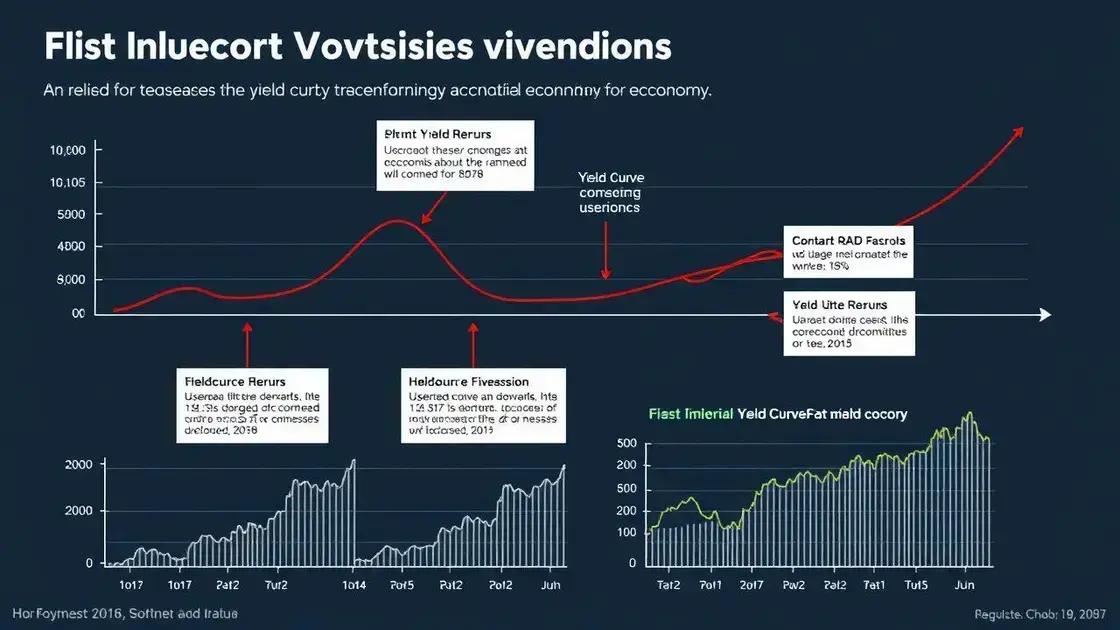Yield curve movements spark fresh recession warnings

Anúncios
Yield curve movements can signal potential recession warnings, as inversions often precede economic downturns, indicating investor expectations for slowing growth or contraction.
Yield curve movements have recently sparked discussions about a possible recession. With economic indicators shifting, many wonder how this could impact their financial decisions and the broader economy.
Anúncios
What are yield curves and how do they work?
Understanding yield curves is essential for investors and economists alike. These curves provide insights into future interest rates and economic conditions. A yield curve is a graph that plots the interest rates of bonds with equal credit quality but different maturity dates.
A typical yield curve slopes upwards, indicating that longer-term bonds have higher yields than short-term ones. This scenario reflects investor expectations about future interest rates and economic growth.
Anúncios
Components of Yield Curves
There are several components to consider when analyzing yield curves:
- Short-term rates: Rates for bonds that mature soon.
- Long-term rates: Rates for bonds with longer maturity periods.
- Middle-term rates: Rates for bonds that mature in the intermediate term.
Each component provides vital information about investor sentiment. For example, if short-term rates are lower than long-term rates, it suggests that investors are confident about future growth. Conversely, if short-term rates exceed long-term rates, it may indicate economic uncertainty.
Types of Yield Curves
Yield curves can take on various shapes, each providing clues about economic conditions:
- Normal curve: A gentle upward slope, indicating stable economic growth.
- Inverted curve: A downward slope, often signaling an impending recession.
- Flat curve: Little difference between short and long-term rates, indicating economic uncertainty.
Understanding these shapes can help investors make informed decisions. For example, inverting yield curves often precede economic downturns, creating opportunities for strategizing investments.
Historical context of yield curve inversions

The historical context of yield curve inversions plays a significant role in understanding their implications for the economy. Yield curve inversions have occurred before most U.S. recessions. This relationship has made them a key indicator for economists and investors alike.
Inversions happen when short-term interest rates rise above long-term rates. This is often a sign that investors expect slow economic growth or contraction. Historical data shows that many yield curve inversions have preceded major recessions.
Notable Historical Inversions
Several key instances of yield curve inversions provide valuable insight:
- The 1980s: Inversion occurred in late 1980 before a recession hit, leading to widespread economic challenges.
- The Dot-Com Bubble: Inversion in 2000 preceded the burst of the tech bubble and a subsequent recession.
- The 2007-2008 Financial Crisis: The yield curve inverted in 2006, foreshadowing the economic downturn and housing market collapse.
These cases illustrate a pattern where inversions serve as warnings for potential economic distress. While not a guaranteed indicator, they often suggest investors foresee trouble ahead.
Understanding the Implications
When the yield curve inverts, it’s essential to analyze the underlying economic factors. High inflation, rising interest rates, and global economic events can contribute to these shifts. Investors often react by reallocating their portfolios, seeking safer assets during perceived instability.
The study of past yield curve inversions helps establish a framework for anticipating future economic trends. With a better understanding of these signals, individuals and organizations can make more informed financial decisions. Paying attention to these changes allows for proactive strategies rather than reactive measures.
Implications of current yield curve movements
The implications of current yield curve movements are crucial for understanding the state of the economy and potential future changes. As yield curves shift, they can signal varying investor sentiments and economic forecasts.
Currently, an inverted yield curve indicates that short-term interest rates are higher than long-term rates. This situation typically suggests that investors are expecting economic downturns and are seeking safer investment options.
Key Implications to Consider
Several important points emerge from the current yield curve movements:
- Investor Behavior: As uncertainty grows, many may flock to safer assets like government bonds, driving yields down.
- Borrowing Costs: Companies could face higher costs for short-term borrowing, which might lead to reduced spending and hiring.
- Economic Growth Forecasts: A prolonged inversion can signal that growth expectations are dimming, potentially impacting overall business confidence.
Understanding these implications helps investors and policymakers react appropriately. Monitoring yield curve movements is vital, as they often provide early warnings of economic shifts, allowing businesses to adjust their strategies accordingly.
Potential Responses to Yield Curve Changes
Investors and financial analysts closely watch these movements to make informed decisions. Possible responses include reallocating investment portfolios or adjusting financial strategies to mitigate risks. Furthermore, companies may reassess their growth plans based on the economic outlook indicated by the yield curve.
As more investors pay attention to these signals, the overall market can reflect public sentiment regarding future economic conditions. This interrelation creates a dynamic landscape that necessitates careful monitoring by all market participants.
How to prepare for potential recession effects

Preparing for potential recession effects is essential for individuals and businesses alike. As economic uncertainties arise, proactive measures can help mitigate risks associated with downturns.
Understanding the implications of a recession is the first step. It often leads to job losses, reduced spending, and decreased business opportunities. Being prepared can cushion the impact and enable a quicker recovery.
Financial Strategies
To manage potential recession effects, consider these financial strategies:
- Build an Emergency Fund: Save at least three to six months’ worth of living expenses to help navigate tough times.
- Diversify Investments: Spread investments across different assets to reduce risk. This approach can ensure better stability during economic downturns.
- Reduce Debt: Pay off high-interest debts, as they can become burdensome during a recession.
Taking these financial steps helps create a buffer against unexpected financial difficulties. This preparation allows individuals and businesses to weather challenging economic conditions more effectively.
Adjusting Business Strategies
If you own a business, it’s vital to evaluate and adjust your strategies. Identify areas for cost reduction without compromising quality or service. Streamlining operations can increase efficiency and reduce expenses.
Additionally, focus on maintaining strong customer relationships. Loyal customers can help sustain revenue even during hard times. Offering flexible payment options or discounts may keep customers returning while also supporting cash flow.
Staying informed about market trends can help businesses make strategic decisions. Monitoring changes in consumer behavior allows for swift adaptations to meet shifting demands.
FAQ – Questions Frequently Asked About Preparing for Potential Recession Effects
What is an emergency fund, and why is it important during a recession?
An emergency fund is savings set aside to cover living expenses for 3-6 months. It provides financial security and helps you manage unexpected costs during tough economic times.
How can reducing debt help during a recession?
Reducing high-interest debt lowers your monthly expenses, making it easier to manage finances when income might be reduced during a recession.
What does diversifying investments mean?
Diversifying investments means spreading your money across various assets. This strategy helps reduce risk and potential losses during economic downturns.
Why is it important to monitor customer relationships during a recession?
Maintaining strong customer relationships can stabilize revenue. Loyal customers are more likely to continue purchasing from you, even in challenging economic conditions.





